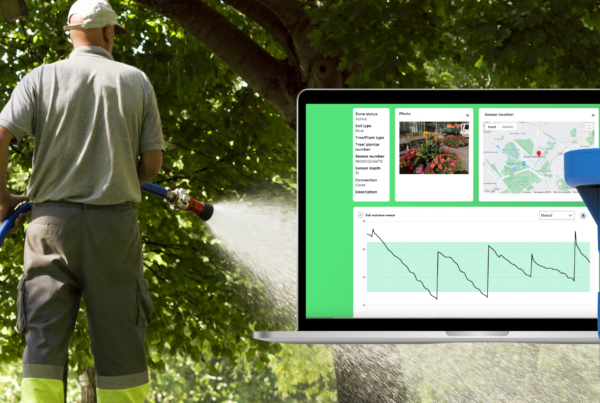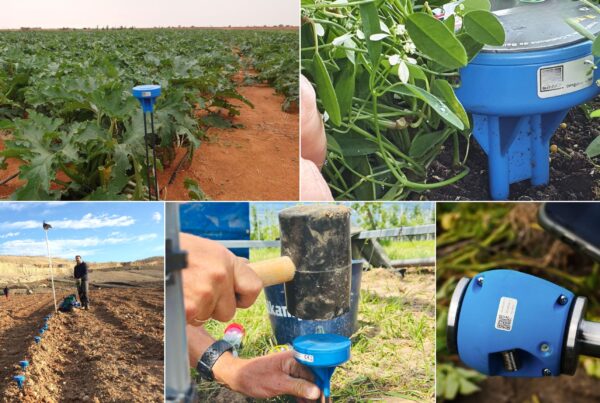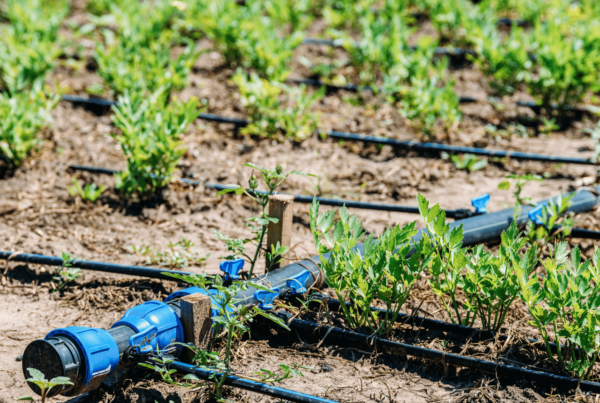Sensoterra’s Soil Moisture Sensors: A Breakthrough Partnership with UC Davis
In an exciting partnership with the esteemed University of California Davis (UC Davis), Sensoterra has embarked on a groundbreaking research project to enhance the accuracy and application of its cutting-edge soil moisture sensors. The collaboration’s primary focus was on assessing the impact of various factors on soil moisture readings, including salinity effects, sensor-to-sensor variability, and temperature dependency. The culmination of this exceptional partnership resulted in the publication of a scientific paper available to the public: “Assessing Effects of Salinity on the Performance of a Low-Cost Wireless Soil Water Sensor,” available on MDPI.
In collaboration with the University of California Davis (UC Davis) a research has been conducted in laboratory to test Sensoterra sensors regarding salinity effects on soil moisture readings, sensor-to-sensor variability and temperature dependency, with the addition to three new calibration curves – with American soils of Oso Flaco sand, Columbia loam and Yolo clay loam soils – to the Sensoterra app. The great partnership resulted in a scientific paper published on MDPI, available for the public: “Assessing Effects of Salinity on the Performance of a Low-Cost Wireless Soil Water Sensor”.
Project goals and brief methodology
Sensoterra and the University of California Davis got together to execute a one-year research project focused on testing Sensoterra soil moisture sensors in laboratory, by the department of Land, Air, and Water Resources. Overall goal consisted of creating new calibration curves, with three of the most common soils for agriculture in the US, in association with sensitivity tests such as salinity (EC), temperature and sensor-to-sensor variability.
Furthermore, to give Sensoterra customers a better insight on ‘what to expect in the field’ when working with Sensoterra sensors, as every field will present variations on soil type, salinity conditions, inputs applied to the soil (irrigation water, pesticides, etc.), plus environmental interferences on temperature change, rain events, sunlight, erosion levels, etc.
Before analysis, preparation was done with crushed, sieved and dried soil, in two equal containers, with uniform bulk density in total of 12 sensors, for each test. Overall tests were conducted with glass beads, Oso Flaco sand, Columbia loam and Yolo clay loam; being the first one only used for testing purposes, with no further applications. Soil samples had predetermined water content variations (from 0.1 to 0.45 m3 m−3) together with different solutions of electrical conductivity (ECw) of 0.5 to 4 dS/m.
Results and discussion
Measurement certainty of soil moisture content:
Precision of Sensoterra soil moisture measurements was quantified based on the comparison between quantified actual water content versus sensors’ measurement, for different soil types and ECw (solution salinity).
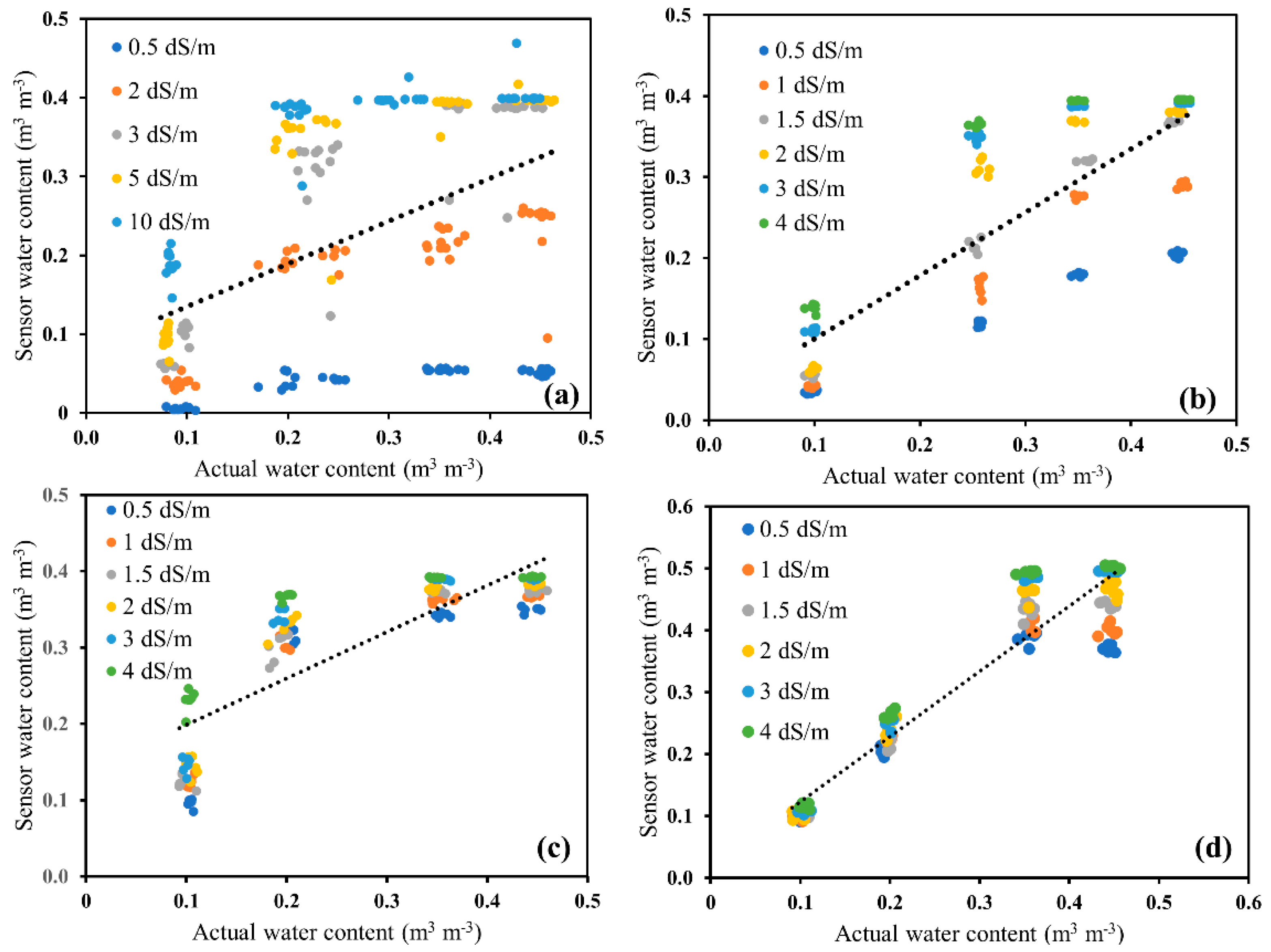
Figure 1: Comparison of combined sensor water content with predetermined actual water content for (a) glass beads, (b) Oso Flaco sand, (c) Columbia loam, and (d) Yolo clay loam over a range of water and electrical conductivity solutions.
Results:
-
- Salinity effect is more pronounced in sandy soils, followed by loamy and clay loam soils (as the least affected).
- Moisture measurement for glass beads (a) presented the highest variation, with more stable values around 1 dS/m EC.
-
- The considerable variation can be associated to the fact that there was no calibration curve for this particular substrate type, as glass beads is made of silica, mainly used for testing purposes with no applications in the field.
-
- Measurement certainty for sand (b) is more accurate for salinity levels around 1 dS/m (most common salinity level in agriculture) and among drier soils.
- Measurement certainty for loamy soils (c) is more accurate around wetter soils, not significantly affected by salinity, as sensitivity stayed stable within ECw variations from low to high salinity ranges (0.5 to 4 dS/m).
- Measurement certainty for clay loam (d) is more accurate around drier soil ranges, not significantly affected by salinity, as sensitivity stayed stable within ECw variations from low to high salinity ranges (0.5 to 4 dS/m).
- Overall, the effects of changes in ECw differs by soil type. In addition, the effect of salinity on sensor performance in three soil types was reduced from sand to sandy loam to clay loam.
Effect of soil type and solution electrical conductivity on sensor performance:
Salinity effect on Sensoterra soil moisture sensors will vary depending on soil texture and salinity content (either soil and solution/irrigation water). Sensor calibration and testing were conducted using solution salinity values of ECw from 0.5, 1.0, 1.5, 2.0, 3.0, and 4.0 dS/m.
Salinity, also known as electrical conductivity (EC) measures the capacity of the soil to conduct electrical current. The higher the salt content in the soil, the higher the salinity and/or EC.
Sensoterra sensors work on a perfect range of low-medium salinity levels from 0.5-2 dS/m. In case of excessive salinity in the solution (ECw) or in the soil (ECe), sensor readings might be affected by changes in resistance output. These variations will differ per soil texture, as the results below demonstrate:
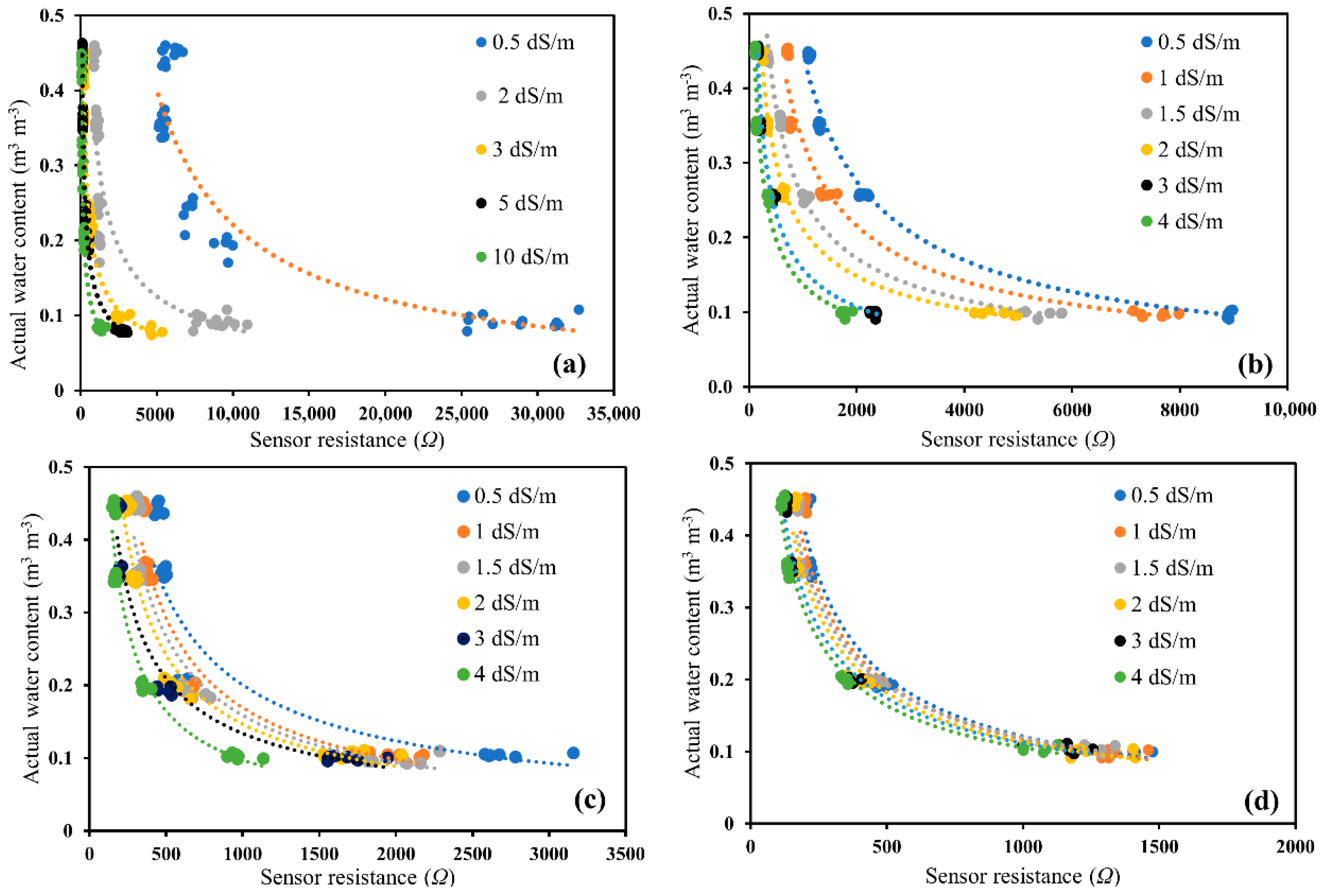
Figure 2: changes in sensor output (resistance) over a range of volumetric water content and solution of electrical conductivity (ECw) for Oso Flaco sand (b), Columbia loam (c), and Yolo clay loam (d).
Results:
-
- Clay loams and loamy soils are less affected by salinity changes (in ECw); being clay loam the less sensitive soil type to salinity/EC changes.
- Glass beads (a) and Oso Flaco sand (b) and sandy soils, in general, are the most sensitive soils when exposed to salinity effects compared to loam (c) and clay (d) soils.
-
- The considerable variation can be associated to the fact that there was no calibration curve for this particular substrate type, as glass beads is made of silica, mainly used for testing purposes with no applications in the field.
-
- Sensors’ sensitivity to salinity is more likely to happen in wetter soils with higher salinity levels of 3-4 dS/m.
Effect of temperature on sensor performance:
The operational temperature range of Sensoterra sensors is from -20° to + 60° Celsius. Temperature dependency will be straightforward as temperature is inversely proportional to resistance. Sensor sensitivity can be manifested in cases of abrupt temperature changes, meaning changes in resistance values (sensors output in Ohms).
In cases of extreme temperatures – for high or low – moisture content may be wetter (increased temperature) or drier (reduced temperature) than reality.
Secondly, soil conductivity is highly dependent on temperature changes. This means that salinity is temperature dependent, and it may change with temperature variations – indirectly affecting moisture readings as mentioned above.
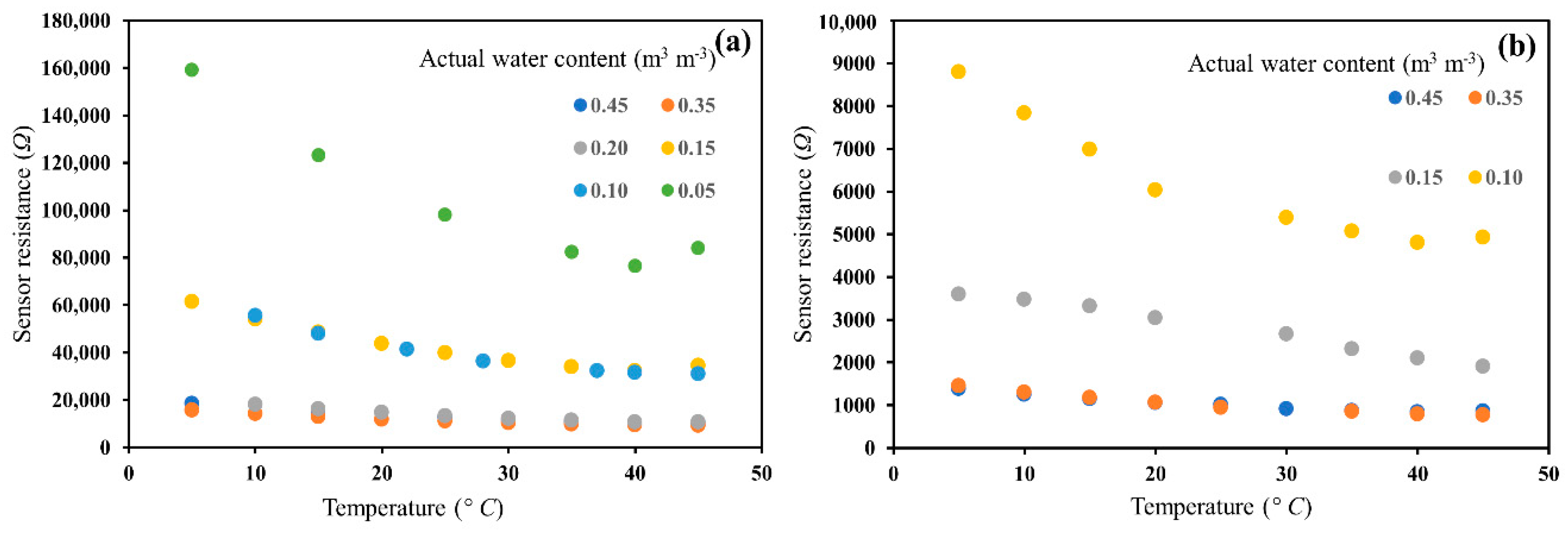
Figure 3: Response of the sensor to temperature at each actual water content and (a) at ~0.5 dS/m salinity, and (b) at 1 dS/m salinity in glass beads. Sensor data represents the raw data in resistance (Ω) at different temperatures.
Results:
-
- Temperature is inversely proportional to resistance output. Higher temperatures equals lower resistance, enhancing the chances of mismatching moisture readings; values will tend to be wetter than reality. The opposite goes for temperature decrease.
- Temperature effect is bigger in drier soils, when compared to soils with higher water content.
Electrical conductivity (EC), of solutions or soils, increases by about 2% per Celsius degree (temperature).
Salinity distribution over the US
The map below shows soil salinity distribution over the US territory, with strongly saline soils around a few areas of California, Nevada and Utah, and the rest around very-slightly to non-saline. Sensoterra sensors work in all ranges of salinity, with optimal readings from 0.5-2 dS/m, suitable for the majority of the American areas.
Over the Netherlands, common salinity ranges tend to be reduced to 0.5-1.5 dS/m. Sensoterra sensors should perfectly operate within these EC ranges.
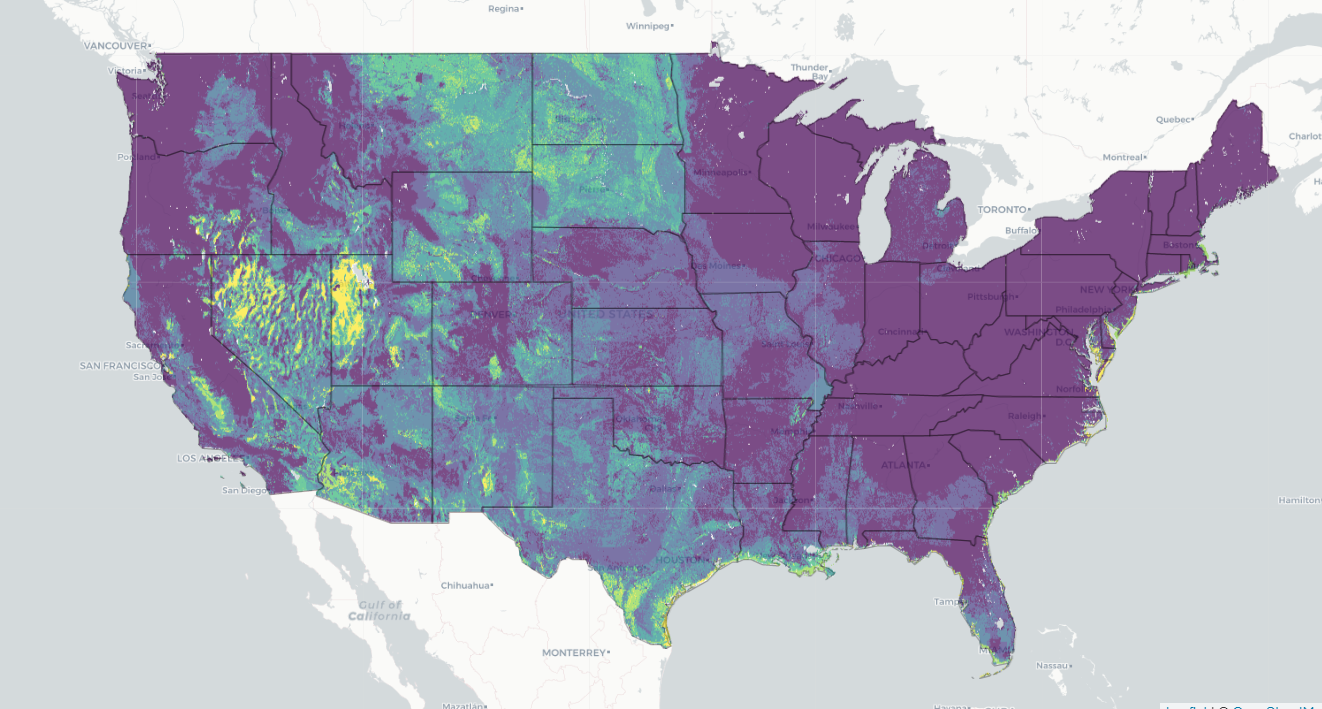
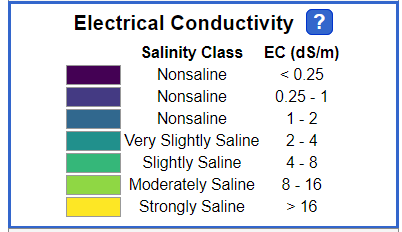
Figure 4: USA map with soil salinity distribution per state. EC ranges go from 0.25 to above 16 dS/m, with strongly saline areas concentrated on the West part of California, Nevada and Utah. Source: https://casoilresource.lawr.ucdavis.edu/soil-properties/
About University of California Davis
The University of California Davis – Soil Resource Laboratory in collaboration with the Department of Land, Air and Water Resources – is one of the biggest research institutes of Soil Sciences worldwide. In years of research they have published multiple scientific papers in collaboration with other universities and industry partners; including one of their latest projects SoilWeb tool to map soil survey data all over the US via Google map.
About Sensoterra
Sensoterra is a global leader in soil moisture sensing, with wireless, robust and easy-to-install sensors. The facility of LoRaWAN connectivity allows the sensors to be used from urban to the most remote areas for agriculture, horticulture, smart cities and landscaping. With the serious commitment to keep improving sensors efficiency, likewise, customers’ experience, Sensoterra invests in different collaborations with scientific and industry partners.
Glossary of terms
Electrical conductivity (EC) = property of the soil that quantifies how strongly it resists or conducts electric current. It measures the amount of salt in the soil.
ECe = soil salinity.
ECw = irrigation water salinity.
Resistance = is the output of Sensoterra readings, expressed in Ohms (Ω). Called as the ‘raw data’, Sensoterra sensors originally measure resistance to be converted into volumetric water content. The wetter the soil, the lower the resistance, and vice versa.
About Sensoterra
Sensoterra develops low-cost, simple, and robust wireless soil moisture sensors, providing actionable insights that enable water management platforms and solutions. Our sensors are built to integrate into any platform with our unique ‘API first’ philosophy – offering freedom and flexibility for data integration. It is our mission to enable water management platforms and solutions worldwide. We help by ‘Making Sense of Water’. We produce simple, robust, and low-cost wireless soil moisture sensors that are easy to deploy and built to integrate. With proven success in the applications of smart city landscaping, environmental monitoring, and precision agriculture, the Sensoterra solution integrates seamlessly in existing water and land management platforms.
Learn more at www.sensoterra.com
Contact for more information, pictures and/or interview requests:
Jessica Nuboer
Marketing & Communications
Sensoterra
Email: [email protected]

